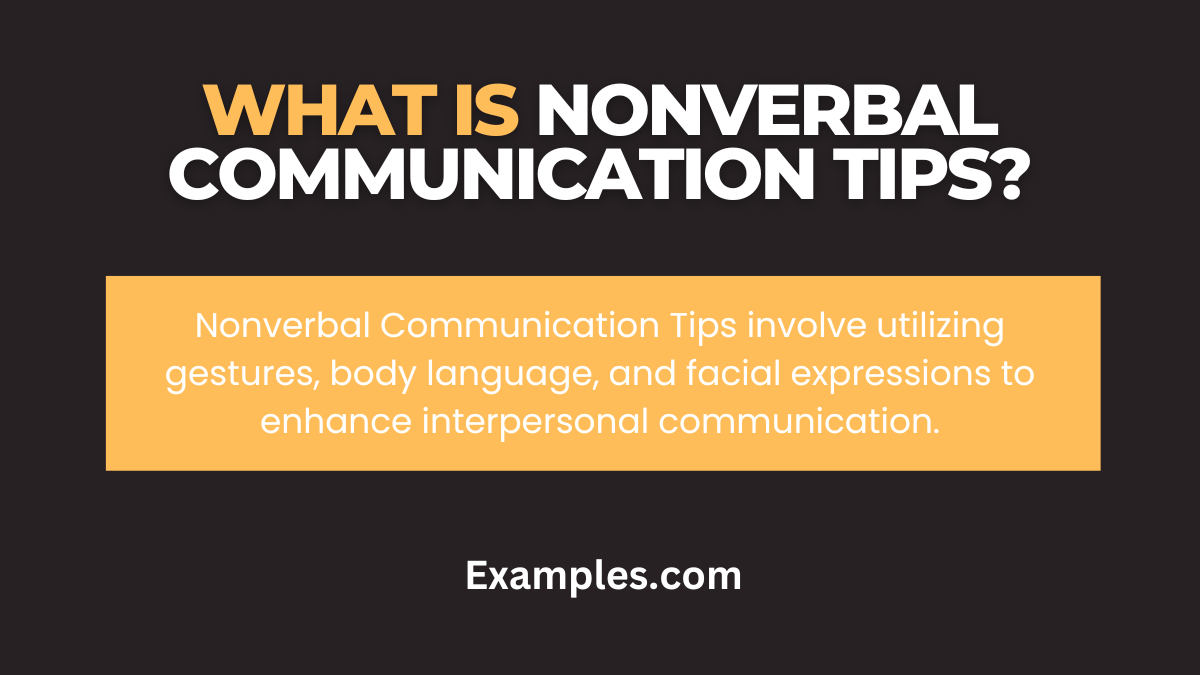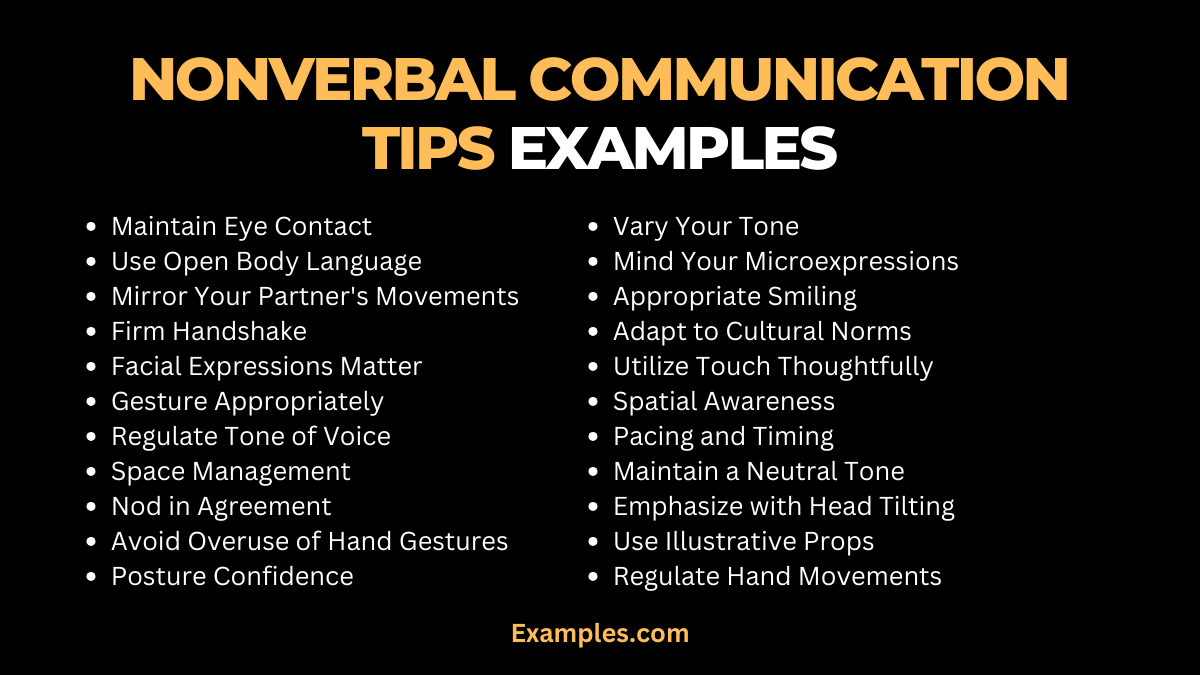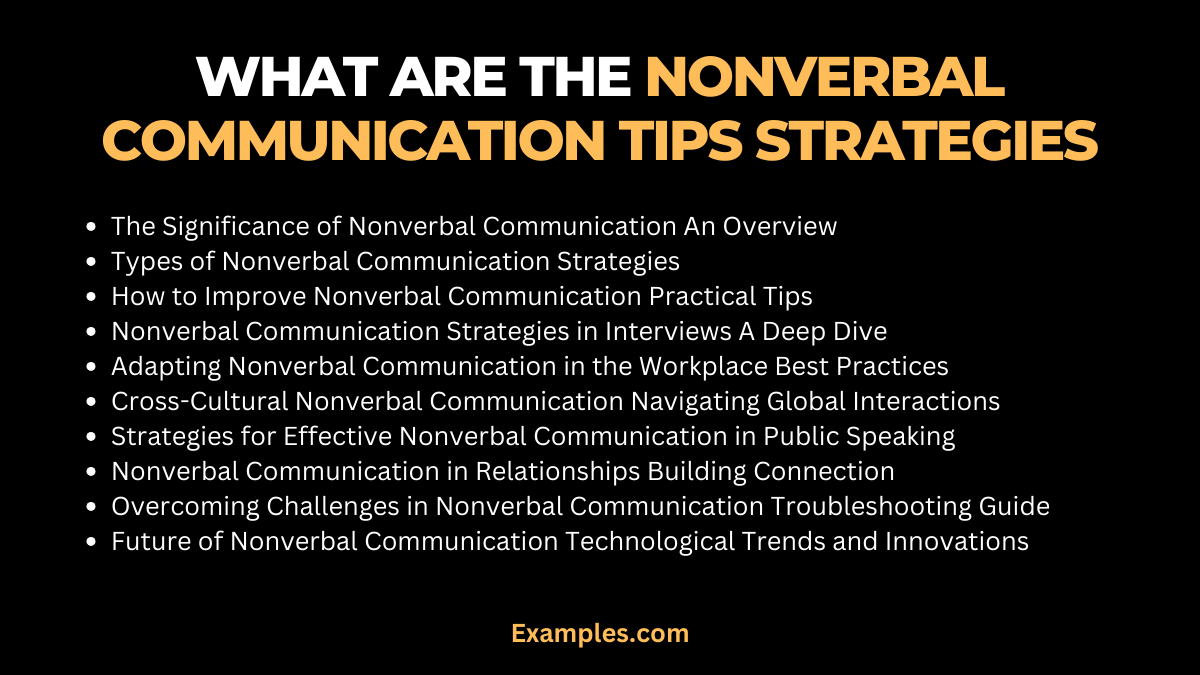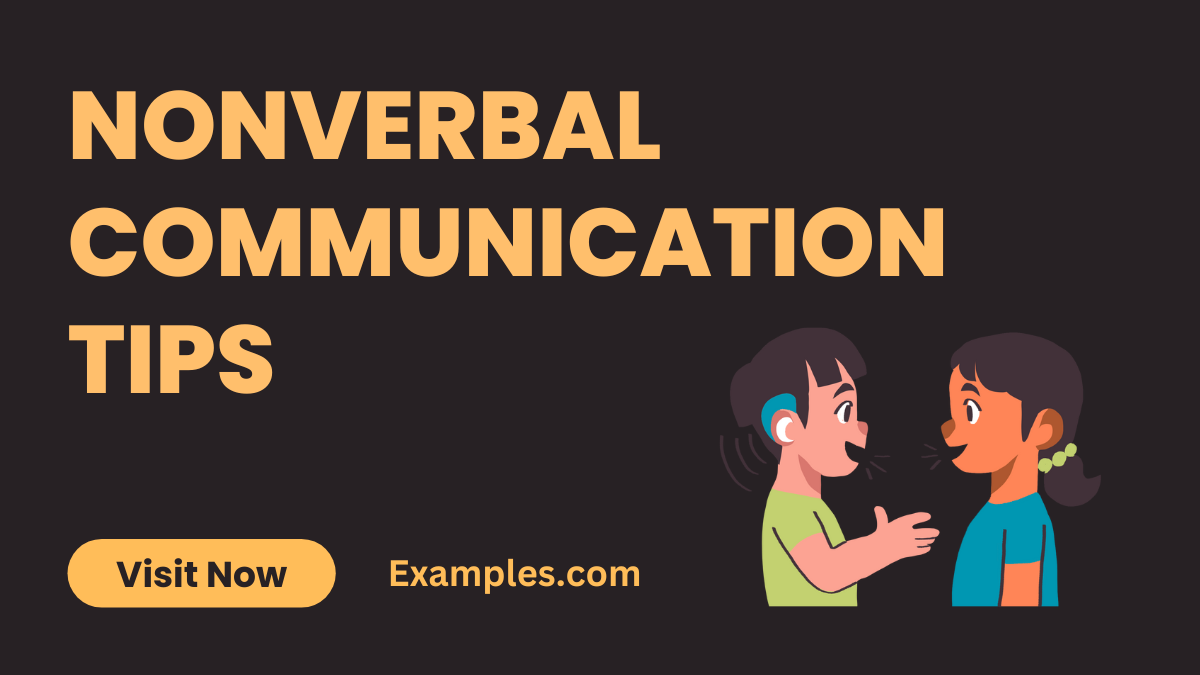29+ Nonverbal Communication Tips Examples
Unlock the secrets of impactful communication with our comprehensive guide on Nonverbal Communication Tips. In this enriching exploration, we delve into proven strategies and provide Communication Examples to sharpen your skills. From mastering interviews to excelling in the workplace, our guide empowers you with insights to navigate diverse communication scenarios. Elevate your verbal and nonverbal prowess, creating a lasting impact in both personal and professional spheres. Explore the art of communication with tangible examples for unparalleled success.
What is Nonverbal Communication Tips?

Nonverbal Communication Tips encompass a range of strategies that go beyond words. In simple terms, it involves expressing and interpreting messages through gestures, body language, facial expressions, and more. This guide demystifies the concept, offering a clear definition to enhance your communication skills. Dive into the world of nonverbal cues to grasp their significance and learn how to apply these tips effectively in various aspects of your personal and professional life.
What is the Best Example of Nonverbal Communication Tips?
One standout example of Nonverbal Communication Tips is the skill of maintaining eye contact during an interview. This seemingly simple action conveys confidence, attentiveness, and sincerity. Our detailed exploration reveals the nuances behind this gesture, breaking down its impact on interpersonal dynamics. Learn why sustained eye contact is a powerful nonverbal cue, how it varies across cultures, and why it can be a game-changer in professional settings. Elevate your communication prowess by understanding and applying this noteworthy example of nonverbal communication.
30 Nonverbal Communication Tips Examples

Explore our comprehensive guide featuring 100 Nonverbal Communication Tips Examples, meticulously curated to enhance your communication skills. From mastering interviews to excelling in the workplace, each tip is a gem designed to elevate your nonverbal prowess. Dive into this treasure trove of insights for a nuanced understanding of effective communication.
- Maintain Eye Contact: Establish trust and convey confidence by maintaining steady eye contact during conversations.
- Use Open Body Language: Foster a welcoming environment by avoiding closed-off gestures, such as crossed arms.
- Mirror Your Partner’s Movements: Build rapport effortlessly by subtly mirroring the body language of the person you’re communicating with.
- Firm Handshake: Convey professionalism and assertiveness with a firm handshake, leaving a positive first impression.
- Facial Expressions Matter: Your facial expressions can speak volumes; ensure they align with the message you wish to convey.
- Gesture Appropriately: Enhance verbal communication by incorporating gestures that complement and emphasize your words.
- Regulate Tone of Voice: Convey emotions effectively by modulating your tone to match the context of the conversation.
- Space Management: Respect personal space boundaries to create a comfortable and respectful interaction.
- Nod in Agreement: Show active listening and engagement by nodding in agreement during discussions.
- Avoid Overuse of Hand Gestures: While gestures are powerful, avoid excessive use to prevent distraction from your verbal message
- Posture Confidence: Stand or sit upright to exude confidence and project a positive image
- Vary Your Tone: Use variations in pitch and pace to add emphasis and convey the nuances of your message.
- Mind Your Microexpressions: Be mindful of fleeting facial expressions that can reveal underlying emotions.
- Appropriate Smiling: Smile genuinely to create a warm and approachable atmosphere, but be mindful of appropriateness.
- Adapt to Cultural Norms: Understand and respect cultural differences in nonverbal communication practices.
- Utilize Touch Thoughtfully: Use touch sparingly and appropriately to convey warmth and connection.
- Manage Fidgeting: Minimize fidgeting to appear calm, composed, and in control during interactions.
- Spatial Awareness: Be aware of the physical space around you to avoid making others feel crowded or distant.
- Pacing and Timing: Adjust your pace and timing to match the rhythm of the conversation for better flow.
- Maintain a Neutral Tone: Avoid sounding confrontational by maintaining a neutral and composed vocal tone.
- Emphasize with Head Tilting: Show empathy by tilting your head slightly during empathetic moments in conversation.
- Use Illustrative Props: Enhance your message by incorporating relevant props that support your verbal communication.
- Regulate Hand Movements: Calmly control hand movements to avoid distraction and maintain focus on your message.
- Adopt a Relaxed Stance: A relaxed stance communicates openness and ease in social interactions.
- Monitor Facial Tension: Relax facial muscles to prevent conveying tension or stress during conversations.
- Gesture for Emphasis: Use purposeful gestures to emphasize key points and capture attention.
- Adjust Seating Position: Shift your seating position to demonstrate engagement and active participation.
- Eye Contact in Group Settings: Distribute eye contact evenly in group settings to include all participants in the conversation.
- Match Nonverbal Cues with Verbal Message: Ensure consistency between your verbal and nonverbal cues for effective communication.
- Mind Your Proximity: Adjust your proximity to convey intimacy or maintain professional boundaries, depending on the context.
Nonverbal Communication Tips During an Interview:
Navigate interviews with finesse using our exclusive Nonverbal Communication Tips. Elevate your nonverbal acumen to create a lasting impression, from maintaining eye contact to mastering body language. Seize the opportunity to convey confidence and competence in every nonverbal cue.
- Firm Handshake: A confident handshake sets the tone for a positive interaction, demonstrating professionalism and assurance.
- Mirror Interviewer’s Energy: Subtly align your energy with the interviewer’s to establish rapport and connection.
- Expressive Facial Gestures: Use facial expressions to convey enthusiasm, interest, and alignment with the discussed topics.
- Regulate Nervous Habits: Be conscious of nervous habits, such as fidgeting, to maintain a composed and collected appearance.
- Adapt Seating Posture: Adjust your seating posture to reflect engagement and active participation throughout the interview.
- Dress Appropriately: Your attire is a nonverbal statement. Dress professionally to match the formality of the interview setting.
- Control Vocal Pace: Modulate your speech pace to match the rhythm of the conversation, emphasizing key points effectively.
- Mind Spatial Awareness: Be aware of personal space to respect boundaries, ensuring a comfortable interview environment.
- Calm Microexpressions: Keep microexpressions in check to avoid unintentionally revealing nervousness or stress.
- Articulate Confidence: Speak with conviction and confidence, utilizing a clear and well-projected vocal tone.
Nonverbal Communication Tips for Success
Uncover the secrets of success through Nonverbal Communication Tips. Learn to communicate with impact, whether in the workplace, social settings, or personal interactions. From body language mastery to effective space management, our tips guide you toward achieving success through nonverbal excellence.
- Confident Posture: Stand tall and convey confidence through your posture, exuding assurance and success.
- Strategic Gestures: Use purposeful gestures to emphasize key points, capturing attention and reinforcing your message.
- Empathetic Listening: Demonstrate success by actively listening and responding with empathetic nonverbal cues.
- Polished Appearance: Present yourself with a polished appearance to reflect professionalism and attention to detail.
- Appropriate Use of Props: Enhance your message by incorporating relevant props that support and illustrate your points.
- Dynamic Facial Expressions: Expressiveness in facial expressions adds depth and authenticity to your communication, fostering connection.
- Engaging Eye Contact: Establish a strong connection with others through genuine and engaging eye contact.
- Adaptive Vocal Tone: Adjust your vocal tone to match the context, conveying authority, empathy, or enthusiasm as needed.
- Open and Inclusive Body Language: Foster a sense of inclusivity by maintaining open and inviting body language.
- Purposeful Movement: Move with purpose and intention, reinforcing your confident and successful presence in any setting.
Nonverbal Communication Skills in the Workplace:
Navigate the intricacies of the workplace with our Nonverbal Communication Skills guide. From fostering a positive work environment to effectively conveying ideas, master the art of workplace communication through nonverbal cues.
- Professional Handshakes: Cultivate positive workplace relationships with professional and friendly handshakes.
- Office Space Management: Be mindful of spatial awareness to respect colleagues’ personal space, fostering a comfortable environment.
- Visual Communication Techniques: Utilize visual aids and nonverbal cues to enhance your message and ensure effective workplace communication.
- Collaborative Body Language: Encourage collaboration through open and inclusive body language during team interactions.
- Adaptable Tone in Meetings: Adjust your vocal tone in meetings to convey authority, enthusiasm, or receptivity based on the agenda.
- Respectful Seating Arrangements: Display respect for hierarchy and collaboration by thoughtful seating arrangements in meetings and discussions.
- Engagement in Group Discussions: Demonstrate active engagement in group discussions through attentive listening and appropriate nonverbal cues.
- Effective Use of Presentation Props: Enhance presentations with purposeful props that visually reinforce key points and engage the audience.
- Professional Dress Code: Uphold a professional image through appropriate attire, aligning with workplace expectations.
- Consistent Nonverbal Messaging: Ensure consistency between verbal and nonverbal messages to convey clarity and credibility in workplace communication.
What are the Nonverbal Communication Tips Strategies?

In the realm of effective communication, nonverbal cues play a pivotal role in conveying messages, emotions, and intentions. Understanding and harnessing these nonverbal communication strategies can significantly enhance your interpersonal skills.
1. The Significance of Nonverbal Communication An Overview
Delve into the fundamental importance of nonverbal communication, exploring how it complements verbal messages and contributes to overall understanding.
2. Types of Nonverbal Communication Strategies
Explore the diverse landscape of nonverbal communication strategies, encompassing body language, facial expressions, gestures, and more.
3. How to Improve Nonverbal Communication Practical Tips
Uncover actionable tips and techniques to enhance your nonverbal communication skills. From mastering eye contact to refining your posture, this section provides practical advice for immediate implementation.
4. Nonverbal Communication Strategies in Interviews A Deep Dive
Navigate the nuances of applying nonverbal communication strategies in interview settings. Understand how to convey confidence, professionalism, and authenticity to leave a lasting impression.
5. Adapting Nonverbal Communication in the Workplace Best Practices
Explore best practices for employing nonverbal communication strategies in professional settings. Learn to navigate workplace dynamics, foster collaboration, and project a positive image.
6. Cross-Cultural Nonverbal Communication Navigating Global Interactions
Delve into the intricacies of nonverbal communication across cultures. Understand how cultural nuances influence nonverbal cues and develop strategies for effective communication in diverse environments.
7. Strategies for Effective Nonverbal Communication in Public Speaking
Discover how to use nonverbal communication strategies to captivate and engage audiences during public speaking engagements. From confident gestures to strategic eye contact, elevate your speaking presence.
8. Nonverbal Communication in Relationships Building Connection
Examine the role of nonverbal communication in fostering meaningful connections within personal relationships. Learn strategies for expressing emotions, building trust, and enhancing intimacy.
9. Overcoming Challenges in Nonverbal Communication Troubleshooting Guide
Address common challenges in nonverbal communication and explore solutions to overcome barriers. Whether dealing with misinterpretations or navigating conflicting cues, this section offers practical guidance.
10. The Future of Nonverbal Communication Technological Trends and Innovations
Explore emerging trends and technological advancements shaping the landscape of nonverbal communication.
Tips to Improve Nonverbal Communication:
Nonverbal communication is a powerful aspect of human interaction, influencing how we connect, convey messages, and establish relationships. Enhancing your nonverbal communication skills can significantly impact your personal and professional life.
- Hone Your Body Language: Cultivate positive body language by avoiding closed-off gestures. Open and inviting postures contribute to a more approachable and communicative presence.
- Perfect Your Handshake: A firm handshake exudes professionalism and sets a positive tone for any interaction. Master the balance between strength and warmth.
- Modulate Your Tone of Voice: The tone of your voice carries emotional nuances. Practice modulating your tone to match the context, conveying empathy, authority, or enthusiasm as needed.
- Utilize Facial Expressions Effectively: Facial expressions add depth and authenticity to your communication. Learn to express emotions congruently with your verbal message.
- Pay Attention to Proxemics: Be mindful of personal space to create a comfortable environment. Respect others’ boundaries, adjusting your proximity based on the context.
- Gesture with Purpose: Purposeful gestures emphasize key points and contribute to a dynamic and engaging communication style. Avoid excessive or distracting movements.
- Adapt to Cultural Differences: Understand and respect cultural variations in nonverbal communication. Tailor your approach to align with the expectations of diverse audiences.
- Fine-Tune Your Listening Skills: Nonverbal cues play a crucial role in active listening. Demonstrate attentiveness through appropriate nods, facial expressions, and body language.
- Stay Present and Mindful: Practice mindfulness in your interactions. Being present in the moment enhances your ability to read and respond to nonverbal cues effectively.
- Master the Art of Eye Contact: Maintain steady eye contact to convey confidence, sincerity, and engagement. It fosters trust and enhances the overall impact of your communication.
Incorporating these tools in different contexts is crucial. For further insights into nonverbal communication in the workplace, the University of California offers valuable information on the significance of nonverbal cues in professional settings at UCPath. Additionally, for a comprehensive understanding of nonverbal communication in relationships and its impact on effective communication, HelpGuide provides an in-depth guide at HelpGuide.org. Both resources offer a broader perspective on the role of nonverbal communication beyond its use in aiding those with speech or language difficulties



